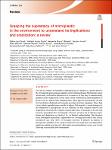Thông tin tài liệu
Thông tin siêu dữ liệu biểu ghi
| Trường DC | Giá trị | Ngôn ngữ |
|---|---|---|
| dc.contributor.author | Borah, Shikha Jyoti | - |
| dc.contributor.author | Gupta, Abhijeet Kumar | - |
| dc.contributor.author | Gupta, Akanksha | - |
| dc.date.accessioned | 2023-08-25T02:13:16Z | - |
| dc.date.available | 2023-08-25T02:13:16Z | - |
| dc.date.issued | 2023 | - |
| dc.identifier.uri | https://link.springer.com/article/10.1007/s10853-023-08806-8 | - |
| dc.identifier.uri | https://dlib.phenikaa-uni.edu.vn/handle/PNK/8933 | - |
| dc.description | CC-BY | vi |
| dc.description.abstract | Over the last century, accumulation of microplastic has emerged as a greater threat to the environment, plants, microorganisms and even human beings. Microplastics can be intentionally produced for industries such as cosmetics, or they may be unintentionally generated from degradation of bulk plastic debris. Furthermore, mismanagement of plastic waste is a major source of microplastics. When ingested, microplastics can alter several physical, chemical and biological processes in living organisms. Thus, their toxicity silently spreads its roots into the biosphere. Unfortunately, current strategies for the elimination of microplastics are not sufficient for their complete removal and degradation. Therefore, the adoption of green innovative technologies is the first step toward a microplastic-free environment. | vi |
| dc.language.iso | en | vi |
| dc.publisher | Springer | vi |
| dc.subject | accumulation of microplastic | vi |
| dc.subject | human beings | vi |
| dc.title | Grasping the supremacy of microplastic in the environment to understand its implications and eradication: a review | vi |
| dc.type | Book | vi |
| Bộ sưu tập | ||
| OER - Khoa học Vật liệu, Ứng dụng | ||
Danh sách tệp tin đính kèm:

